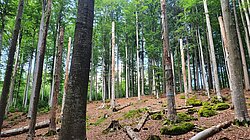Effects of silvicultural interventions on biodiversity
New methods allow new insights

Goal
The main objective of the project is to gain new insights into the effects of different silvicultural interventions using innovative methods of biodiversity research
Description
Social debates about interventions in forests are steadily increasing, up to court rulings dealing with interventions in Natura 2000 forests. Increasingly, this discussion includes interventions taken after disturbance events, such as drought stress, insect damage or fire, as well es conventional interventions in the context of silvicultural practices. To date, there is a lack of studies investigating silvicultural interventions including integrative conservation approaches such as deadwood biodiversity enrichment. At the same time, new methods have emerged in recent years that are able to record overall arthropod communities, quantify complex acoustic diversity, or even measure insect stress levels. These innovative approaches will be applied here for the first time in silvicultural experimental plots.
The study is based on a design of 8 forest plots of the colline to montane stage of mixed deciduous forests of medium age. In these experimental plots with a size of 50x50 m the following 9 variants were realized: (i) thinning, (ii) thinning with standing deadwood, (iii) thinning with lying deadwood, (iv) thinning with lying and standing deadwood, (v) gap cutting, (vi) gap cutting with standing deadwood, (vii) gap cutting with lying deadwood, (viii) gap cutting with standing and lying deadwood, and an (ix) control without intervention. On these plots, we will use sound recorders to sample acoustic diversity and evaluate it by using a high-performance cluster computer at the University of Würzburg. Using a trap mix of malaise trap, window trap and pitfall trap and identification by metabarcoding, the community of arthropods and the functional diversity of the plots will be determined. Stress levels will be assessed on selected species using neuronal monoamine levels. All identified target variables will be related to treatments or forest structures using generalized mixed models.
Duration
since 2021
Funded by
Bavarian State Institute of Forestry (LWF - L062)







